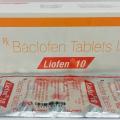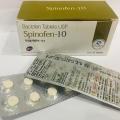Home / Categories / EUBAC-10MG

EUBAC-10MG
(10TX10S)
BACLOFEN-10MG
CNS DEPRESSANT
KEVA PHARMACEUTICALS PVT.LTD
Product Details
Baclofen
A to Z Drug Facts
Baclofen
Action
Indications
Contraindications
Route/Dosage
Interactions
Lab Test Interferences
Adverse Reactions
PrecautionsPatient Care Considerations
Administration/Storage
Assessment/Interventions
Patient/Family Education
(BACK-low-fen)LioresalTablets: 10 mg, 20 mgIntrathecal: 0.05 mg/mL (50 mcg/mL), 10 mg/20 mL (500 mcg/mL), 10 mg/5 mL (2000 mcg/mL)APO-Baclofen, Dom-Baclofen, Gen-Baclofen, Lioresal, Lioresal Intrathecal, Med-Baclofen, Nu-Baclo, PMS-BaclofenClass: Skeletal muscle relaxant/Centrally acting
 Action May inhibit transmission of reflexes at spinal level, possibly by action (hyperpolarization) at primary afferent fiber terminals resulting in relief of muscle spasticity; has CNS depressant properties.
Action May inhibit transmission of reflexes at spinal level, possibly by action (hyperpolarization) at primary afferent fiber terminals resulting in relief of muscle spasticity; has CNS depressant properties.
 Indications
Indications
Oral: Treatment of reversible spasticity resulting from multiple sclerosis. May be of some value in patients with spinal cord injuries and other spinal cord diseases. Intrathecal: Treatment of severe spasticity of spinal cord origin in patients who are unresponsive to or cannot tolerate oral baclofen therapy. Used intrathecally in single bolus test doses; chronic use requires implantable pump. Unlabeled use(s): Oral: Therapy for trigeminal neuralgia (tic douloureux); tardive dyskinesia. Intrathecal: Cerebral palsy spasticity in children.
 Contraindications Treatment of spasms from rheumatic disorders, stroke, cerebral palsy and Parkinson disease; use of intrathecal form via IV, IM, SC, or epidural routes.
Contraindications Treatment of spasms from rheumatic disorders, stroke, cerebral palsy and Parkinson disease; use of intrathecal form via IV, IM, SC, or epidural routes.
 Route/Dosage
Route/Dosage
ADULTS: Initial dose: PO 5 mg tid; may be increased by 5 mg/dose q 3 days prn to max 80 mg/day (20 mg qid). Intrathecal Refer to manufacturer's manual for implantable pump.
Screening
ADULTS: 1 mL of 50 mcg/mL dilution is administered into the intrathecal space by barbotage over 1 min and patient is observed for 4 to 8 hr; may be repeated 24 hr later with 75 mcg/1.5 mL and 48 hr later with 100 mcg/2 mL. Do not give implantable pump to patients not responding to 100 mcg bolus. CHILDREN: The starting screening dose for pediatric patients is the same as in adult patients (eg, 50 mcg). However, for very small patients, a screening dose of 25 mcg may be tried first.
Postimplant Dose Titration Period
To determine the initial total daily dose of baclofen following implant, double the screening dose that gave a positive effect and administer over a 24-hr period.
Spasticity of Spinal Cord Origin
ADULTS: Intrathecal After the first 24 hr, increase the daily dosage slowly 10% to 30% increments and only once q 24 hr, until desired effect is achieved.
Spasticity of Cerebral Origin
ADULTS: Intrathecal After the first 24 hr, increase the daily dose slowly 5% to 15% once q 24 hr, until desired clinical effect is achieved. CHILDREN: After the first 24 hr, increase the daily dose slowly 5% to 15% only once q 24 hr, until the desired effect is achieved.
Maintenance Therapy
Very often the maintenance dose needs to be adjusted during the first few months of therapy while patients adjust to changes in lifestyle because of the alleviation of spasticity.
Spasticity of Spinal Cord Origins
ADULTS: Intrathecal During periodic refills of the pump, the daily dose may be increased 10% to 40%, but no more than 40%, to maintain adequate symptom control. Maintenance dose for long-term continuous infusion has ranged from 12 to 2003 mcg/day, with most patients adequately maintained on 300 to 800 mcg/day.
Spasticity of Cerebral Origin
ADULTS: Intrathecal During the periodic refills of the pump, the daily dose may be increased 5% to 20%, but no more than 20%. Ranges from 22 to 1400 mcg/day, with most patients adequately maintained on 90 to 703 mcg/day. CHILDREN LESS THAN 12 YR: Average daily dose 274 mcg/day. Requires individual titration. Use the lowest dose with an optimal response. CHILDREN AT LEAST 12 YR: Same as adult. Determination of the optimal dose requires individual titration. Use the lowest dose with an optimal response.
 Interactions
Interactions
CNS depressants: May cause increased sedative effects. Morphine (epidural): May cause hypotension and dyspnea.
 Lab Test Interferences May cause false elevation of AST, alkaline phosphatase, or blood glucose.
Lab Test Interferences May cause false elevation of AST, alkaline phosphatase, or blood glucose.
 Adverse Reactions
Adverse Reactions
CV: Hypotension; palpitations; chest pain. CNS: Drowsiness; weakness in lower extremities; dizziness; seizures; headache; numbness; euphoria; depression; confusion; lethargy; insomnia. DERM: Pruritus; rash. EENT: Tinnitus; blurred vision; taste disorder; nasal congestion. GI: Nausea; vomiting; dry mouth; constipation; diarrhea; abdominal pain; anorexia. GU: Urinary frequency; enuresis; dysuria; impotence. RESP: Dyspnea. OTHER: Hypotonia; slurred speech; muscle pain; ankle edema; excessive perspiration; weight gain.
 Precautions
Precautions
Pregnancy: Category C. Lactation: Excreted in breast milk. Children: Safety of oral baclofen in children less than 12 yr and of intrathecal baclofen in children less than 4 yr has not been established. Abrupt discontinuation: Abrupt discontinuation of intrathecal baclofen has resulted in sequelae that include high fever, altered mental status, exaggerated rebound spasticity, and muscle rigidity, which in rare cases has advanced to rhabdomyolysis, multiple organ system failure, and death. Intrathecal use: Only specially trained personnel should administer drug intrathecally because of potentially life-threatening CNS depression, cardiovascular collapse, or respiratory failure. Epilepsy and psychotic disorders: Use with caution because of potential exacerbations. Fatalities: Fatalities occurred in premarketing trials of intrathecal baclofen; role of baclofen in these deaths is unknown. Infection: Patients should be infection-free before screening trial with baclofen injection. Renal impairment: Administer with caution. Dosage reduction may be necessary. Stroke: Drug has not significantly benefited patients with stroke; these patients also have poor drug tolerance.
PATIENT CARE CONSIDERATIONS
 Administration/Storage
Administration/Storage
Oral
- Administer with milk or food to avoid GI upset.
- Dilute intrathecal medication per manufacturer's instructions.
Intrathecal
- If there is not a substantive clinical response to increases in the daily dose, check for proper pump function and catheter patency.
- The daily maintenance dose may be reduced 10% to 20% if patients experience side effects.
- Have resuscitation equipment available during trial drug period if intrathecal administration is considered. Patient must have positive response to trial of intrathecal medication before use of implantable pump.
- Store at room temperature in tightly closed container.
 Assessment/Interventions
Assessment/Interventions
- Obtain patient history, including drug history and any known allergies. Note any signs of infection.
- Assess muscle spasticity and monitor throughout course of therapy.
- Monitor renal function prior to administration.
OVERDOSAGE: SIGNS & SYMPTOMS Vomiting, muscular hypotonia, muscle twitching, drowsiness, accommodation disorders, coma, respiratory depression, seizures. Intrathecal: Drowsiness, lightheadedness, dizziness, somnolence, respiratory depression, seizures
 Patient/Family Education
Patient/Family Education
- Instruct patient to take drug exactly as prescribed. If dose is missed it should be taken within 1 hr. Warn patient not to double up on doses.
- Explain that full effectiveness of drug may not occur until several weeks after initiation of drug therapy.
- Warn patient not to discontinue medication abruptly. Explain that hallucinations or seizures may occur.
- Instruct patient to avoid intake of alcoholic beverages or other CNS depressants.
- Teach patient to avoid sudden position changes to prevent orthostatic hypotension.
- Caution diabetic patient that false elevation of blood glucose may occur. Instruct patient to monitor blood glucose carefully.
- Instruct patient to report the following symptoms to health care provider: dizziness, nausea, hypotension, urinary frequency, retention, painful urination, headache, seizures, weakness.
- Advise patient that drug may cause drowsiness, and to use caution while driving or performing other tasks requiring mental alertness.
Books@Ovid
Copyright © 2003 Facts and Comparisons
David S. Tatro
A to Z Drug Facts
Substitutes



